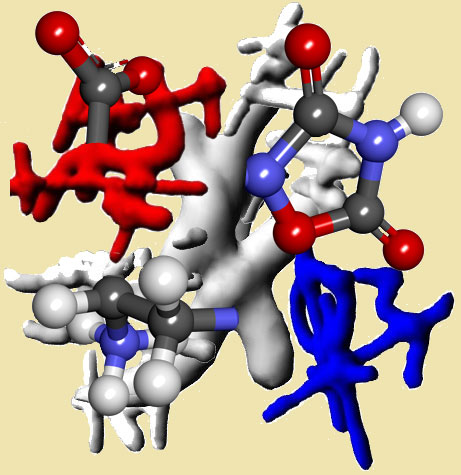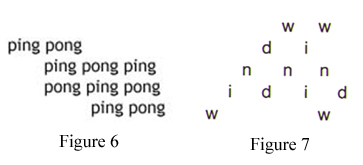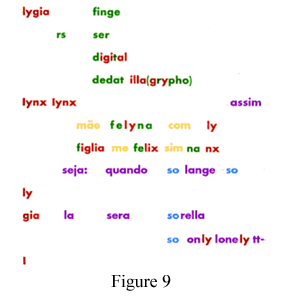
remix of michael manning phone art; hat tip Nullsleep for stick and ball molecule
In connection with the "Telefone Sem Fio" show I'll be giving a talk on Dec. 7--more on this soon. The show celebrates the work of Augusto De Campos, a Brazilian poet who, together with his brother Haroldo and Decio Pignatari formed the Noigandres group in the '50s. Am reading an essay by Marjorie Perloff about them (hat tip Alessandra) and thinking about how much or little concrete poetry has to do with "the internet" or "net art."
1. Perloff begins her essay with this quote from poet/artist/Ubuweb founder Kenneth Goldsmith:
Everything [Pignatari] was saying seemed to predict the mechanics of the internet . . . delivery, content, interface, distribution, multi-media, just to name a few. ... [I]t’s taken the web to make us see just how prescient concrete poetics was in predicting its own lively reception half a century later... [W]hat had been missing from concrete poetry was an appropriate environment in which it could flourish. For many years, concrete poetry has been in limbo: it’s been a displaced genre in search of a new medium. And now it’s found one.
Sounds great but Perloff offers little proof that any of this is true. At the end of her essay she considers some examples of De Campos' poems rendered as interactive Flash video but the bulk of her writing is concerned with rehabilitating the concrete poets for other reasons, after they fell out of favor with the Academy in the '80s and '90s. Ultimately it seems like she's damning the movement with faint praise: "Thus Concretism, cutting-edge (literally!) as this arrière-garde was vis-à-vis the normative verse or painting of its own day, transformed the Utopian optimism and energy of the pre-World War I years into a more reflective, self-conscious, and complex project of recovery."
2. History:
(i) Perloff says: "Eugen Gomringer, generally considered the father of concrete poetry... differed from [the Brazilian-born Swedish poet Oyvind] Fahlström, as from the Campos brothers, in coming out of an artistic rather than a literary milieu. As early as 1944, he had seen the international exhibition of concrete art organized by Max Bill in Basel, and in 1944-45, he made the acquaintance of Bill and Richard Loehse at the Galerie des Eaux Vives in Zurich. Soon, he was collaborating with two graphic artists, Dieter Rot and Marcel Wyss, to create a new journal called Spirale. Bauhaus, Hans Arp, Mondrian and Der Stilj—these were Gomringer’s chief visual sources."

[^This is the sort of modernist kitsch I think of when I hear "concrete poetry" --TM]
(ii) "In 1953 Fahlström published a “Manifesto for Concrete Poetry” under the title Hipy papy bithithdthuthda bthuthdy, a version of “Happy Birthday” he took from A. A. Milne’s Winnie-the-Pooh."
(iii) The road to political incorrectness: "in 1956, Gomringer declared that 'Concrete poetry is founded upon the contemporary scientific-technical view of the world and will come into its own in the synthetic-rationalistic world of tomorrow.' This functional definition of a 'universal poetry' brings concretism dangerously close to industrial design and conformity to the political-ideological status quo," says Perloff, adding: "In 1967, Gomringer took on the position of chief design consultant for Rosenthal, the famous china and glass manufacturer, and increasingly his work became that of consolidation rather than innovation."
(iv) Brazil: The Noigandres group breaks with Gomringer, looking back to Pound, Joyce, and other figures from the early 20th Century avant garde.
3. Perloff: "[Brazilian] concrete poetry, as represented by [Augusto's] Lygia... is less a matter of iconicity or even spatial design, striking as that design is, than it is conceived as verbivocovisual composition, all of whose materials have a signifying function. Pound’s familiar distinction between melopoeia, phanopoeia, and logopoeia is applicable here, but note that phanopoeia is transferred from the realm of representation (e.g., the word or word group as effective 'image' of X or Y) to that of the materiality of the poem: its sound (emphasized by color) and its visual appearance on the page."

See Perloff for translation and unpacking of the complexities of the above. But then De Campos also did this, which for all the cleverness of its construction has aged poorly and looks like a return to the Gomringer school:

4: '80s/'90s theorists dismissed concrete poetry, claiming it was impaired not just by capitalist design cooties but the "iconic fallacy" first announced in Plato's Cratylian argument "that the sound and visual properties of a given word have mimetic value." Perloff, recanting her earlier criticism, distinguishes the Noigandres canon as "not a 'fallacy' in the sense Caroline Bayard took it to be one, for the whole point is that poetry is that discourse in which astre [star] and desastre [disaster] do belong together even if, in ordinary discourse, there is no meaningful relationship between the two." Good poets aren't mindlessly literal--who knew?
5. Perloff says an avant garde needs a rear guard to protect and consolidate its advances. Two ways the Noigandres did this: (i) Haroldo's demystification of Chinese characters and his more informed use of ideographic elements based on this research and (ii) taking the concrete poetry avant garde into the realm of the "digital" via, e.g., Augusto's experiments with electronic poems and interactive video. The latter doesn't seem very rear-guard since these tools didn't exist in Pound's day. Also, while Flash video is certainly a tool of the Net it is not the same as "the internet," which a decade after De Campos' Flash work we understand to be a more busy, polyglot place full of intriguing expressions that don't necessarily frame themselves as art. To make the case in Kenneth Goldsmith's statement above--that "the Internet" makes the concrete poets relevant again--would take another article.